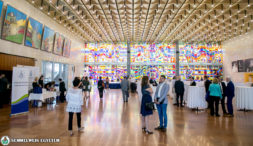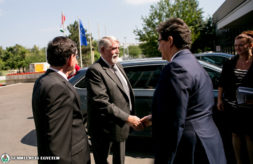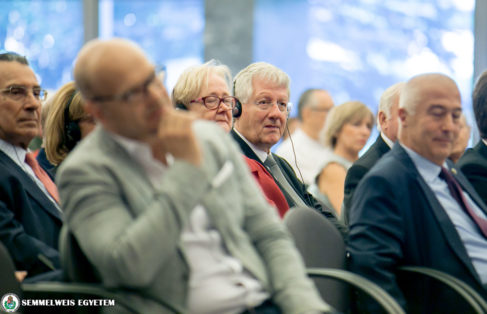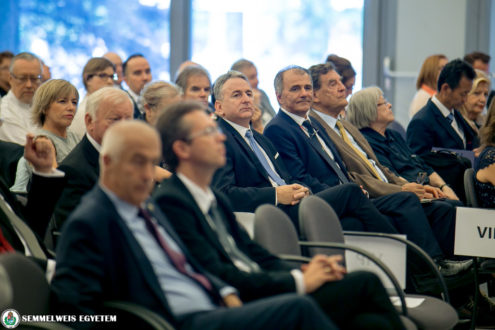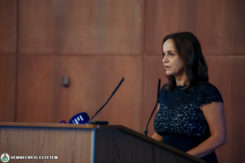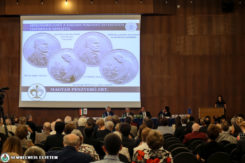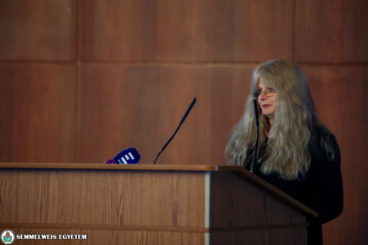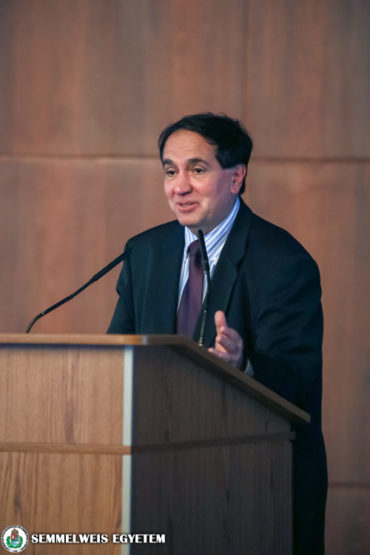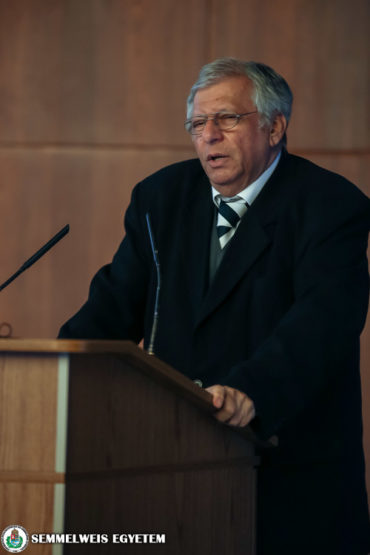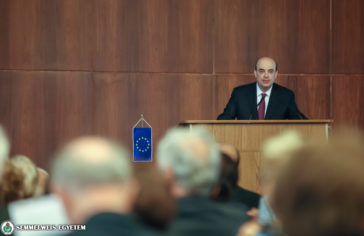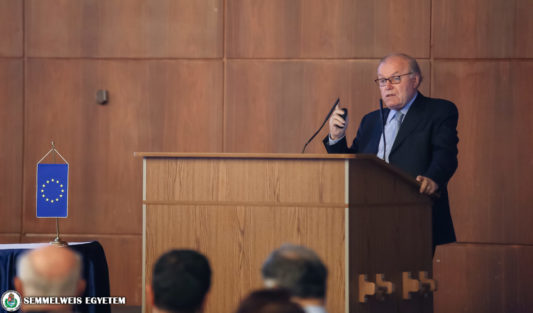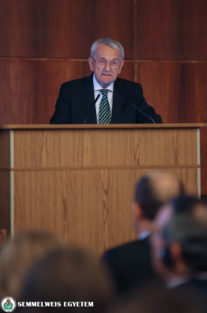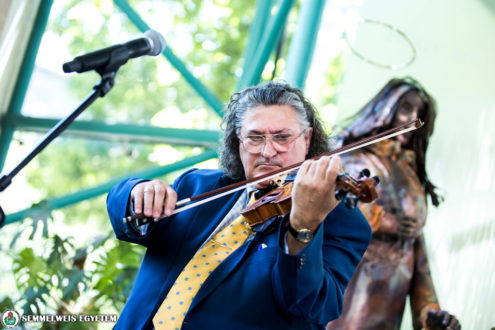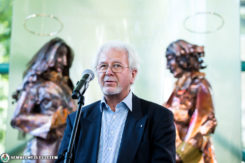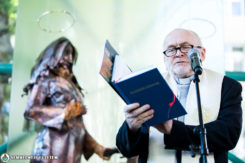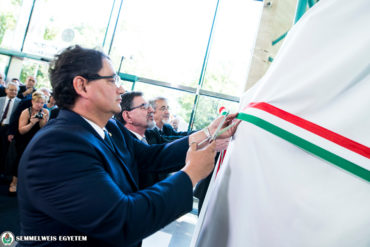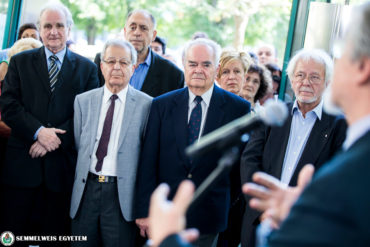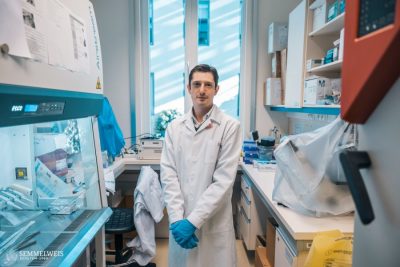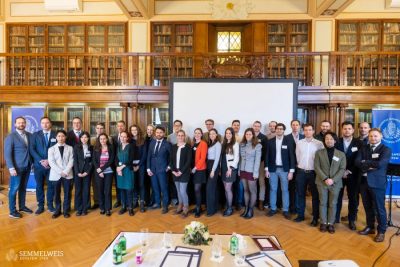At one of the most important events of the Ignác Semmelweis memorial year in honour of the 200th anniversary of the birth of Semmelweis, at the Festive Scientific Symposium held in the Theoretical Block of Semmelweis University at Nagyvárad tér, several national and foreign speeches were given about the saviour of mothers. The Semmelweis-medallions issued by the Central Bank of Hungary and the Semmelweis-stamp issued by the Hungarian Post were introduced at this event. More than 600 participants were welcomed by Dr. Miklós Kásler, Minister of Human Capacities, and Dr. Ágoston Szél, outgoing rector of Semmelweis University. The final speeches were given by Dr. Béla Merkely, who took his rector’s office on 1st July and Dr. József Bódis, State Secretary of Education. After the conference, István Madarassy’s statue “In blessed state – Visitation in memory of Semmelweis” was unveiled in the hall of the External Clinical Block at Korányi Healthcare Building.
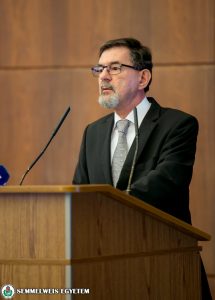 In his welcome speech, Dr. Ágoston Szél recalled that the university would be 250 years old the following year and had been bearing the name of Semmelweis for almost 50 years. As Dr. Szél stated, Semmelweis’ recognition was rejected probably because of its simplicity and ingenuity in his era: “it is a tragedy that the doctors in the 19th century were not prepared for taking in handwashing, which was astonishing that time” – he also highlighted that today Semmelweis is believed to be the hero not only of obstetrics but also of surgery, epidemiology, hygienics, biostatistics and several other medical majors.
In his welcome speech, Dr. Ágoston Szél recalled that the university would be 250 years old the following year and had been bearing the name of Semmelweis for almost 50 years. As Dr. Szél stated, Semmelweis’ recognition was rejected probably because of its simplicity and ingenuity in his era: “it is a tragedy that the doctors in the 19th century were not prepared for taking in handwashing, which was astonishing that time” – he also highlighted that today Semmelweis is believed to be the hero not only of obstetrics but also of surgery, epidemiology, hygienics, biostatistics and several other medical majors.
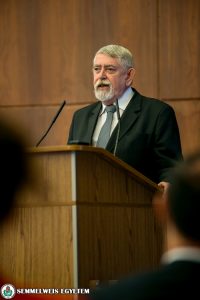 Ignác Semmelweis is one of the most well-known, most honoured and beloved people of the Hungarian medicine – claimed Dr. Miklós Kásler. The Minister of Human Capacities explained the Semmelweis’ fate was almost parallel with the events of the Hungarian Revolution and War of Independence, the motivation was also similar: the unconditional love of truth and the preservation of the freedom of research. The salvation of human life was in Semmelweis’ focus. The minister highlighted that Semmelweis’ memory puts serious responsibility onto the Hungarian medical world and the university bearing his name.
Ignác Semmelweis is one of the most well-known, most honoured and beloved people of the Hungarian medicine – claimed Dr. Miklós Kásler. The Minister of Human Capacities explained the Semmelweis’ fate was almost parallel with the events of the Hungarian Revolution and War of Independence, the motivation was also similar: the unconditional love of truth and the preservation of the freedom of research. The salvation of human life was in Semmelweis’ focus. The minister highlighted that Semmelweis’ memory puts serious responsibility onto the Hungarian medical world and the university bearing his name.
After the greetings, Eszter Hergár, CEO for Social Contacts of the Central Bank of Hungary, introduced the “Semmelweis Memorial Year” medallions, issued by the Central Bank of Hungary and designed by Gábor Kereszthury, an industrial designer. The silver medallion has 10,000Ft nominal value and the non-ferrous metal medallion has 2,000Ft nominal value. Afterwards, Gabriella Nikodém, Director of Stamp Museum gave her speech on the Semmelweis-stamp and together with Dr. Miklós Kásler by the first postmark they put the stamp in circulation and signed the occasional envelopes.
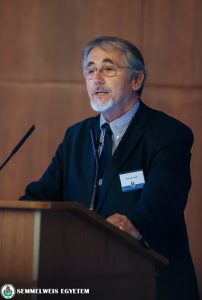 The first professional lecture was given by Dr. László Rosivall, President of the Semmelweis Commemorative Committee and main organiser of the event. The professor emeritus outlined the most important events of the memorial year, among others the Semmelweis-drama written by Jens Bjorneboe in 1958 and first performed with great success in Hungary last year in the National Theatre. It was also performed by the students of Deák Tér Lutheran Secondary School in the Department of Anatomy, Histology and Embryology. With the help of the Committee, several Semmelweis statues were unveiled in the world to honour the saviour of mothers. The memory book titled Semmelweis 200, gives unknown details and data about Semmelweis.
The first professional lecture was given by Dr. László Rosivall, President of the Semmelweis Commemorative Committee and main organiser of the event. The professor emeritus outlined the most important events of the memorial year, among others the Semmelweis-drama written by Jens Bjorneboe in 1958 and first performed with great success in Hungary last year in the National Theatre. It was also performed by the students of Deák Tér Lutheran Secondary School in the Department of Anatomy, Histology and Embryology. With the help of the Committee, several Semmelweis statues were unveiled in the world to honour the saviour of mothers. The memory book titled Semmelweis 200, gives unknown details and data about Semmelweis.
Dr. Frank A. Chervenak (New York) gave his lecture titled “Ethical dimensions of puerperal sepsis 170 years ago and today”, Dr. István Gazda spoke about Semmelweis from the medical historian’s point of view, Dr. Roberto Romero (Detroit) gave his presentation titled „New challenges of maternal and fetal infections in the 21st century” Dr. László Kiss (Csilizradvány) introduced the connection between Semmelweis and the Medical Journal, Dr. Asim Kurjak (Zágráb) gave his speech titled “The role of ultrasound in prevention and management of perinatal sepsis” and Dr. Zoltán Papp gave his presentation on “Commemoration of the late departmental successor of Ignác Semmelweis”.
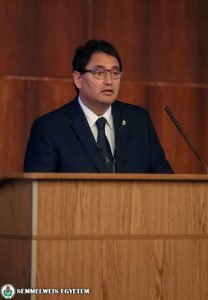 The closing speech was presented by Dr. Béla Merkely, Rector. He claimed that Semmelweis University is the flagship of medical- and health science education, research and healing care in Hungary and in the region. He also stated the university’s position in the international rankings, its outstanding publication activity and its internationalism. He emphasised that the main task, according to Semmelweis’ spirit, in the future is to have the university among the 100 best higher educational institutions in the world. The goal is that Semmelweis University will educate the best physicians, pharmacist doctors, health care professionals, conductors and managers not only for Hungary and our nation but also for our wider region – stated the rector.
The closing speech was presented by Dr. Béla Merkely, Rector. He claimed that Semmelweis University is the flagship of medical- and health science education, research and healing care in Hungary and in the region. He also stated the university’s position in the international rankings, its outstanding publication activity and its internationalism. He emphasised that the main task, according to Semmelweis’ spirit, in the future is to have the university among the 100 best higher educational institutions in the world. The goal is that Semmelweis University will educate the best physicians, pharmacist doctors, health care professionals, conductors and managers not only for Hungary and our nation but also for our wider region – stated the rector.
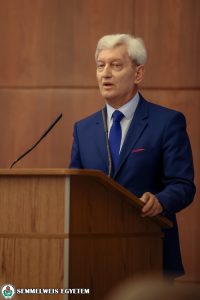 Jubilees and ceremonies are important, however, the salute was filled with real content by the university that had adopted Ignác Semmelweis’ name 49 years ago and has gained significant results in education, research, scientific results and healing – told to the audience Dr. József Bódis, State Secretary of Education, the outgoing rector of the University of Pécs. The President of the Hungarian Society of Obstetrics and Gynaecology added that nowadays we would need geniuses similar to Semmelweis who would find a solution for decreasing the high rate of premature birth.
Jubilees and ceremonies are important, however, the salute was filled with real content by the university that had adopted Ignác Semmelweis’ name 49 years ago and has gained significant results in education, research, scientific results and healing – told to the audience Dr. József Bódis, State Secretary of Education, the outgoing rector of the University of Pécs. The President of the Hungarian Society of Obstetrics and Gynaecology added that nowadays we would need geniuses similar to Semmelweis who would find a solution for decreasing the high rate of premature birth.
After the conference, István Madarassy’s statue “In blessed state – Visitation in memory of Semmelweis was unveiled in the hall of the External Clinical Block at Korányi Healthcare Building.
Dr. László Rosivall professor emeritus, president of the Semmelweis Commemoration Committee remembered that he had agreed on the creation of the work with the world-famous artist in 2015, the goal of the statue was to be connected to the saviour of mothers in its message rather than in its shape. This is how the fire painted copper statue was created, which captures the biblical meeting of two blessed women, the Virgin Mary and St. Elizabeth.
This is an occasion for art, which is often faced with science, even though this work also shows that they fit well together – said Dr. Ágoston Szél, the outgoing rector of Semmelweis University in his festive greeting. He added that every piece of art carries the message transmitted by the creator.
Ignác Semmelweis basically determines the university’s thinking and exemplifies the three-fold mission of education, research and healing – emphasized Dr. Béla Merkely, the rector of Semmelweis University taking office from July 1. Nowadays this building is our most modern block and shows the serious commitment that Ignác Semmelweis brought with himself every single day when he went to work – he said also adding that pregnant ladies entering this room would feel confidence when looking at the statue.
István Madarassy admitted that creating the statue inspired by M.S. Master’s Visitation image was a heroic struggle not only with the two saints but also with the material. After the unveiling, the statue was blessed by Szabolcs Sajgó, a Jesuit Father who cited from Jesus’s Sermon on the Mount. Finally, Lajos Kathy-Horváth violinist, member of the European Academy of Sciences and Arts performed his improvisation.
Eszter Keresztes
Jeki Gabriella, semmelweis200.hu
Photo: Attila Kovács – Semmelweis University, András Dimény
Translation: Edina Szendreiné Nagy

